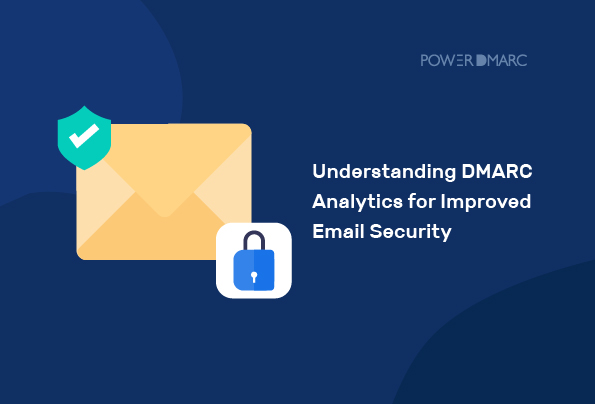Email security has become a crucial aspect of modern communication, and one of the most effective ways to secure emails is through DMARC (Domain-based Message Authentication, Reporting & Conformance). DMARC is an email authentication protocol that allows domain owners to publish a policy on how they want their email to be handled by email receivers.
One of the critical components of DMARC is the use of DMARC analytics. DMARC analytics refers to the process of analyzing DMARC reports, which are sent by email receivers, to gain insights into how the DMARC policy is being implemented. This information can then be used to improve email security and prevent email fraud.
In this blog, we will discuss DMARC and its importance, the process of setting up DMARC records and analyzing DMARC reports, and the benefits of using DMARC analytics for improved email security.
Key Takeaways
- DMARC is essential for domain owners to specify how their emails should be handled by receivers, enhancing email security.
- Analyzing DMARC reports provides insights into email delivery, helping to identify issues that could lead to emails being marked as spam or rejected.
- DMARC analytics aids in preventing email fraud by revealing trends related to email authentication failures.
- Integrating DMARC with other protocols like SPF and DKIM creates a more robust email security framework.
- Improved visibility into email security posture allows domain owners to take informed actions to protect their reputation.
Introduction to DMARC
DMARC is a protocol that allows domain owners to publish a policy on how they want their email to be handled by email receivers. The policy specifies what action the email receiver should take in case of a failed DMARC check, such as marking the email as spam or rejecting it outright.
DMARC works in conjunction with other email authentication protocols, such as SPF (Sender Policy Framework) and DKIM (DomainKeys Identified Mail), to verify the authenticity of the email. It is important to note that DMARC is not an authentication protocol in itself but rather builds upon existing authentication protocols to provide a more comprehensive solution.
Simplify DMARC with PowerDMARC!
Setting up DMARC Records and Analyzing DMARC Reports
To start using DMARC, domain owners must first publish a DMARC record in their domain’s DNS (Domain Name System). The DMARC record specifies the DMARC policy, which includes the desired action in case of a failed DMARC check, and the address where DMARC reports should be sent.
Once the DMARC record is published, email receivers will begin sending DMARC reports to the specified address. These reports provide detailed information about how the DMARC policy is being implemented and how many emails are passing or failing the DMARC check.
The process of analyzing DMARC reports is crucial in understanding the effectiveness of the DMARC policy. DMARC analytics tools are used to analyze DMARC reports and provide insights into how the DMARC policy is being implemented. These tools also provide information on which emails are passing or failing the DMARC check and why, which can help to identify any potential security issues and prevent email fraud.
Benefits of Using DMARC Analytics for Improved Email Security
- Improved Email Deliverability: DMARC analytics helps domain owners understand how their emails are being handled by email receivers. This information can then be used to improve email deliverability by addressing any issues that might be causing emails to be marked as spam or rejected.
- Prevention of Email Fraud: DMARC analytics provides detailed information on which emails are passing or failing the DMARC check and why. This information can be used to identify any potential security issues and prevent email fraud, such as phishing or spoofing attacks.
- Better Understanding of Email Security: DMARC analytics provides domain owners with a better understanding of their email security posture. It allows them to see which emails are passing or failing the DMARC check and why, which can help to identify any potential security issues and prevent email fraud.
- Increased Visibility into Email Security: DMARC analytics provides domain owners with increased visibility into their email security posture. It allows them to see which emails are passing or failing the DMARC check and why which can help to identify any potential security issues and prevent email fraud.
- Better Control Over Email Security: DMARC analytics provides domain owners with better control over their email security posture. By analyzing DMARC reports, domain owners can see how their DMARC policy is being implemented and take action to improve their email security. This increased control over email security helps to prevent email fraud and protect the domain’s reputation.
- Improved Reputation Management: DMARC analytics provides domain owners with the tools they need to protect their reputation. By analyzing DMARC reports, domain owners can see how their emails are being handled by email receivers and take action to address any issues that might be causing emails to be marked as spam or rejected. This helps to maintain a positive reputation and improve the overall deliverability of emails.
- Integration with Other Email Security Solutions: DMARC analytics can be integrated with other email security solutions, such as SPF and DKIM, to provide a comprehensive solution for email security. This integration allows domain owners to take advantage of multiple security protocols to improve the security of their emails.
Conclusion
In conclusion, DMARC analytics is a critical component of email security. By analyzing DMARC reports, domain owners can gain insights into how their DMARC policy is being implemented and take action to improve their email security posture. DMARC analytics provides domain owners with the tools they need to prevent email fraud, improve email deliverability, and maintain a positive reputation. By using DMARC analytics, domain owners can have better control over their email security and protect their reputation.
